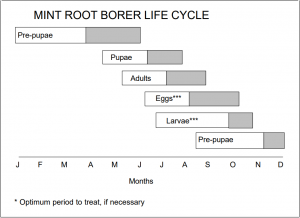Fumibotys fumalis – Mint Root Borer (MRB)




These moths typically start to appear in early June and begin egg-laying shortly thereafter, tapering off by August. Eggs are initially white or translucent in appearance but darken over a 24h period. Newly hatched caterpillars feed on mint leaves before dropping to the soil surface in search of rhizomes. Once inside a mint rhizome, larvae spend several months feeding and can severely damage stands.
In-season control of MRB can be accomplished with timed applications of chlorantraniliprole (Coragen @ 0.045 to 0.098lb ai/acre or Voliam Flexi @ 0.1 to 0.125lb ai/acre). Optimal control of MRB can be achieved by making an application after peak moth catch and before larvae migrate into mint rhizomes. Adequate control can still be achieved after larvae migrate into mint stems but these later applications must occur prior to the last irrigation event.
In addition, larvae can be sampled post-harvest in late August through mid-September, when most larvae are large enough to detect, but have not caused much damage. Screen square-foot soil samples taken at 1-4 inch depth and treat with chlorpyrifos (Lorsban @1.9lb ai/acre) or ethoprop (Mocap @3lb ai/acre) when larvae number from two to four per sample – depending on stand age, stand vigor, and oil prices.
Mint root borer feed on underground mint rhizomes in the fall and can kill or seriously injure a stand. They overwinter as pre-pupae below the soil surface, and begin emergence as adult moths in June.
Moth wings vary from cream to chocolate-brown and are marked with darker lines. MRB moths are ~½” long and have enlarged labial palpi that look like a snout. Eggs are laid on leaf surfaces and hatch within 5-10 days. Early instar larvae feed on the leaves briefly and then drop to the soil and tunnel into rhizomes where they can feed through October. In-season control (eg. Coragen) targets the pest before it drops to the ground.
PNW Pest Management Handbook – Mint Pests


